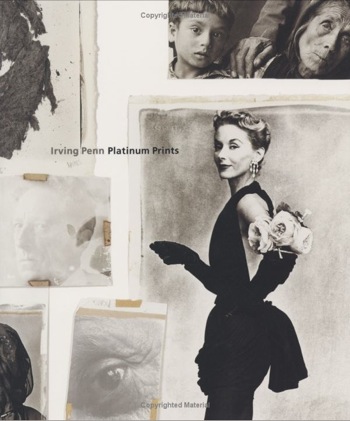The man was a God, but why the pretentiousness?
Proving yet again that there’s no money to be made in Art Books, I splashed out the princely sum of $31.50 on “Irving Penn Platinum Prints”. This book had no expense spared at the altar of authenticity.
Now before you accuse me of being unduly critical, a quick check of my earlier piece on Penn’s fine book “Worlds in a Small Room” may be found here.
The man, clearly, is a God in the history of twentieth century photography.
So when I decided to blow serious coin on “Platinum Prints” it was not without foreboding. I have always eyed anything which purports to apply Secret Sauce to a common or garden process with deep suspicion. And, sadly, skepticism was more than justified in this case.

Yes, the famous pictures are all there – that old fraud Picasso, the future Mrs. Penn (well, at least the guy was straight, or it was one hell of a cover), that great black and white Vogue cover of the mesh vail, the Harley Hell’s Angels disguised as Greek gods, the mud people, Cecil(y) Beaton, all those neo-Sander portraits of horny handed sons of toil, those foul/smelly/gorgeous cigarette butts. In other words, Penn’s finest. No question, the reproduction quality of the prints is beyond criticism.
Then, over that height of civilized existence, the evening vodka Martini, I chanced on the back cover of the book only to see the following solemn inscription: “Over the years I have spent thousands of hours silently brushing on the liquid coatings, preparing each sheet in anticipation of reaching the perfect print. Irving Penn”.
Phew!
So the guy:
1 – Despite working for Vogue with all its resources, values his time so little that he has to make his own prints. Something a trained monkey can do reasonably well.
2 – He elects to waste thousands (thousands – do you believe that?) of hours in a darkroom rather than share more of his great vision with the world.
3 – An exotic process is clearly involved. Do I smell snake oil?
I yield to no one in my admiration for Irving Penn. Unlike his fake contemporary, Richard Avedon, Penn had an eye for what he believed in, not for what would sell. He was the Real Thing.
But then he has to go and tell the world that he is using some inane, archaic process to make his prints. They are no better for the fact that he wasted thousands of hours on them, and that means they really are awfully good. Buy the book, disregard the blurb.
Just because the printing process is complex does not mean the print is a good picture. Thank goodness Penn’s work transcends the nonsense this book propounds.